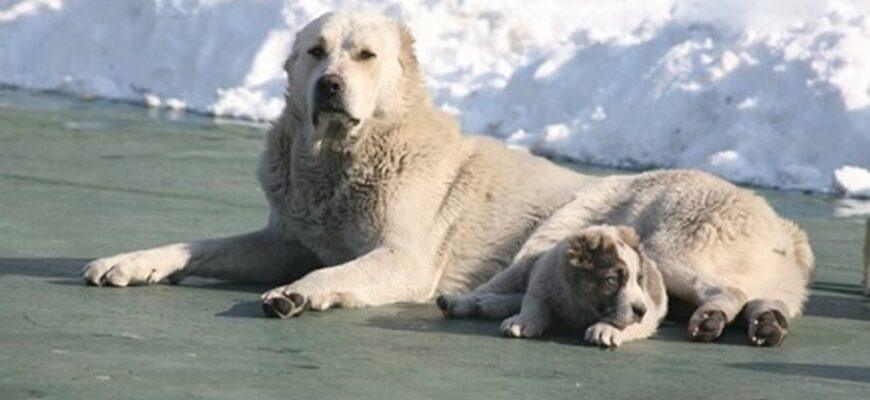Dogs have been more than just companions in Kazakhstan; they embody a rich tapestry of tradition and heritage. Within the expansive steppes, various breeds have evolved, each reflecting the needs and lifestyle of the nomadic culture. Understanding these breeds opens a window into the deeper cultural significance they hold among the Kazakh people.
Kazakhstan is home to several distinctive dog breeds, each with unique characteristics tailored to their environment. Among them, the Alabai stands proudly as a guardian of livestock, while the Tazy embodies the grace of a traditional hunting dog. These breeds not only serve practical purposes but also represent the interwoven history of human and canine companionship in this vast landscape.
In this article, we will explore the diverse ranges of Kazakh dog breeds, spotlighting the Alabai and other notable breeds like the Kazakh Tobet and Tazy. We will also delve into their genetic diversity, historical significance, and the modern challenges they face in an ever-evolving world. Join us as we uncover the fascinating world of Kazakh dog breeds and their enduring legacy.
The Cultural Importance of Dog Breeds in Kazakhstan
Kazakhstan is home to remarkable dog breeds with deep cultural and historical significance. Two prominent breeds, the Tazy and Tobet, are celebrated annually on September 3rd. This day highlights their role as cultural symbols and draws attention to Kazakhstan’s rich ethnographic heritage.
Kazakh Dog Breeds: Cultural Significance
- Tazy: Often proposed to be recognized as Kazakhstan’s national patrimony, the Tazy holds a special place in Kazakh history and culture.
- Tobet: Bred by nomads, the Tobet protected livestock from predators. Ancient petroglyphs show their historical role in Kazakh nomadic traditions.
These breeds are not just pets; they are integral to the nation’s identity. They represent both ethno-cultural and biological value. Their historical presence, from Neolithic times to the Middle Ages, underscores their long-standing importance.
Reasons for Recognition
- Cultural Heritage: These breeds are living symbols of Kazakh culture.
- Historical Presence: Depicted in ancient rock art, they have been crucial in nomadic life.
Kazakhstan’s dedication to preserving these breeds emphasizes their significance in both past and present cultural narratives.
Overview of Kazakh Dog Breeds
Kazakhstan boasts unique dog breeds that have played significant roles in its history and culture. Among these are the Kazakh Tobet and the Alabai, both known for their protective nature and loyalty. These ancient breeds have been part of the region’s nomadic traditions for centuries, serving as vital guardians and companions.
The Alabai: Guardian of the Steppes
The Alabai, also known as the Central Asian Shepherd Dog, is integral to Kazakhstan’s cultural heritage. This breed has a rich history as a livestock guardian. It has long protected sheep and goat herds across Central Asia. Official recognition came in 1990 when Turkmenistan’s State Agroindustrial Committee approved the Turkmen Wolf-Hound standard.
Ancestral Roots
- Region of Origin: Between the Ural River and the Caspian Sea, extending to Asia Minor and Northwest China.
- Historical Evidence: Ancient petroglyphs in Kazakhstan depict large shepherd dogs dating back to the late third to second millennium BC.
Key Traits
The breeding focus of the Alabai emphasizes its working abilities. It has been specifically developed to ward off wolf attacks. Here are some distinct traits:
| Attribute | Description |
|---|---|
| Size | Large, sturdy build |
| Behavior | Loyal, intelligent, and protective |
| Role | Effective as a livestock guardian |
The Alabai excels in harsh climatic conditions and is a testament to the nomadic lifestyle of the region’s people. This breed remains a vital guardian on Kazakhstan’s steppes.
Other Notable Kazakh Dog Breeds
Kazakhstan is home to several unique dog breeds. These dogs hold significant historical and cultural value. While the Alabai is well-known, other breeds also play crucial roles in the country’s history and culture. Let’s explore two: the Kazakh Tobet and the Tazy.
The Kazakh Tobet: Heritage and Functions
The Kazakh Tobet is an indigenous breed with strong roots in Kazakhstan. It is famed for its role in guarding livestock. The breed has a complex genetic structure, featuring seven clusters that indicate high genetic diversity. Historically, the Tobet was not bred for regional purity but for its working qualities. This led to influences from 13th-century Mongolian dogs, enhancing its capabilities.
Over time, crossbreeding with Caucasian Ovcharkas and German Shepherds during the Russian Empire and Soviet era affected the Tobet’s genetic line. Fortunately, interest in preserving this breed has grown since Kazakhstan gained independence in 1991. Efforts are underway to sustain the Kazakh Tobet’s independent genetic lineage. Despite its cultural and historical importance, some Russian and European authorities only view it as a regional variant of the Central Asian Shepherd Dog. Historically, the Tobet has been used for roles like property guarding and companionship. The breed features strong territorial instincts and loyalty to its owner.
The Tazy: The Traditional Greyhound of Kazakhstan
The Tazy is a beloved breed in Kazakhstan, recognized for its prowess in hunting. These sighthounds are known for catching prey without damaging pelts or meat. An estimated 3,000-3,500 Tazys exist in Kazakhstan today.
In a significant step, a law to preserve the Kazakh Tazy was enacted on January 3, 2023, taking effect on July 1 of the same year. The International Canine Federation (FCI) granted preliminary recognition to the Tazy, with Kazakhstan as its breed standard holder in September. Local cynologists are working hard, advocating for the Tazy to gain acknowledgment as a distinct breed nationally and internationally. This recognition would honor its rich history and role as a hunting companion in the Kazakh steppes.
These efforts highlight the importance of preserving the Tazy and ensuring its legacy continues for generations to come.
Genetic Diversity in Kazakh Dog Breeds
Kazakhstan is home to unique dog breeds known for their diversity and history. The Kazakh Tobet stands out among these. This breed displays significant genetic diversity. Research shows seven distinct genetic clusters within the breed. This variety is traced back to the nomadic lifestyle of Kazakh people. Their selective breeding and crossbreeding practices have also played roles. These factors have shaped the Kazakh Tobet’s unique genetic landscape.
Insights from Genetic Studies
Recent studies on the Kazakh Tobet breed reveal a complex genetic structure. Using whole genome sequencing data, scientists have found seven genetic clusters. This study also shows close genetic ties between Kazakh Tobet, Central Asian Shepherd Dog, and Turkish Akbash. These breeds share a common genetic heritage. The study’s findings emphasize the importance of preserving these breeds. The research highlights the necessity of protecting Kazakh Tobet’s genetic lineage.
Relationships with Other Canine Breeds
Kazakhstan is rich in canine diversity. Contrary to popular belief, the country hosts more than just two breeds. Explorations across the region have revealed many others. Notably, the Tazy and Tobet breeds have received special attention. In January 2023, a law was passed to support their preservation. Further recognition came in September 2023 when the FCI recognized the Tazy as an official breed. The Kazakh government supports these efforts to uphold their national heritage.
Historical Significance of Dog Breeds in Kazakhstan
Kazakhstan is home to some of the oldest dog breeds in the world. Among them, the Tazy stands out as particularly significant. Believed to have appeared in Kazakhstan between 4,000 and 7,000 years ago, the Tazy showcases the deep ties between these dogs and Kazakh culture. Historically prized for their hunting skills, Tazy dogs helped ancient Kazakh villages by tracking animals like gazelles, hares, and wolves.
Similarly, the Kazakh Tobet breed has its roots in nomadic Central Asian cultures. Developed primarily to protect livestock from predators such as wolves, the Tobet reflects Kazakhstan’s rich agricultural heritage. The contribution of these breeds is recognized on Tazy and Tobet Dog Breeds Day, underscoring their historical importance within Kazakh identity and traditions.
The Role of Dogs in Traditional Kazakh Life
Dogs hold great ethno-cultural value in Kazakhstan, serving as a testament to the heritage of Kazakh ancestors. Breeds like Tazy and Tobet not only fulfilled practical roles but also symbolized cultural identity. Despite external criticism, Kazakh enthusiasts continue to celebrate these indigenous dogs and preserve their unique characteristics.
Evidence of the integral role of these dogs can be seen in dedicated events such as Tazy and Tobet Dog Breeds Day. Historically, Tazy dogs were relied upon for their remarkable speed and keen senses, crucial in securing food resources. This reflects the deep relationship between Kazakh people and their canine companions.
Dogs in Folklore and Cultural Artifacts
Dogs have long held a revered place in Kazakh folklore and cultural artifacts. The Kazakh Tobet, for example, descends from dogs that nomadic cultures in Central Asia bred to protect livestock. These dogs feature prominently in Kazakh petroglyphs, from the Neolithic period to the Middle Ages, indicating their historical presence.
The Tobet is seen as more than a companion. It is a relic of nomadic life and a protector of livestock, embodying strength and resilience. Depictions of these dogs in ancestral narratives express the Tobet’s cultural significance, connecting Kazakh people to their historical roots through metaphysical symbols of endurance.
Modern Context and Breeding Practices
Kazakhstan is home to several unique dog breeds, with the Kazakh Tobet being one of the most notable. This breed, thought to have been influenced by Mongolian dogs since the 13th century, maintains a distinct look. Despite being exposed to external influences for many years, the Tobet’s characteristics have remained largely unchanged.
During the Russian Empire and Soviet era, Kazakhstan saw the introduction of foreign breeds, such as the Caucasian Ovcharka and German Shepherd. This mix impacted the purity and traits of native breeds significantly. However, after Kazakhstan’s independence in 1991, there has been a renewed interest in preserving these indigenous dogs. There has been a notable effort to locate and preserve the Kazakh Tobet, with current breeding practices focused on recovering its purity. Sadly, only about 40 authentic Tobet dogs have been reported, highlighting their fragile status today. The decline of breeds like the Kazakh Mastiff throughout the 20th century underlines the challenges in maintaining these cherished indigenous breeds.
Responsible Breeding and Conservation Efforts
The Kazakh Tobet is treasured as a livestock protector and hunting companion. Over time, the purity of this breed has been altered by crossbreeding with foreign dogs during the Russian and Soviet times. After the nation gained independence, a renewed passion to preserve Kazakh dog breeds grew. These efforts to reintroduce traditional livestock-breeding practices aimed to connect these dogs more strongly with the nation’s cultural heritage.
Despite their cultural importance, Kazakh dog breeds face criticism from neighboring countries. Some perceive Kazakhstan’s actions as infringing on their national breeds, reflecting the complex nature of breed identity in the region. A key figure in the conservation of these shepherd dogs aims to create a non-commercial organization dedicated to supporting genetic research. They also plan to offer financial aid to breeders and help farmers access puppies. As of now, there is a call for more funding and government support, which is sorely lacking.
Challenges Facing Kazakh Dog Breeds Today
The authenticity and purity of many Kazakh dog breeds have been compromised due to historical changes. Crossbreeding with breeds such as the Caucasian Ovcharka and German Shepherd during the Soviet era has altered their genetic landscape. The Kazakh Mastiff, in particular, has seen its numbers dwindle, with only a few pure bloodlines left.
Efforts to revive traditional Kazakh breeds post-independence have borne some fruit. Yet, only around 40 pure Tobet dogs have been identified, indicating their rarity. This scarcity suggests that many Kazakh breeds may still be hidden or underrepresented in current breeding efforts. Large-scale expeditions to remote areas might uncover more of these unique breeds.
Historically, emphasis was placed more on the dogs’ working qualities than on preserving regional purity. This focus has made it difficult to maintain the distinct traits of Kazakh dog breeds today. Addressing these challenges requires a dedication to both cultural appreciation and scientific methodologies.
Conclusion: The Future of Kazakh Dog Breeds
The future of Kazakh dog breeds looks promising. Recent advancements have been made to preserve the Kazakh Tazy and Tobet, reflecting the country’s dedication to their cultural heritage. As of July 2023, a new law protects and encourages the breeding of these iconic dogs, ensuring their survival.
The Union of Canine Experts of Kazakhstan joined the International Canine Federation (FCI) in August 2023. This membership paves the way for Kazakhstan’s native breeds to gain international recognition. Research into the genetic diversity of breeds like the Kazakh Tobet shows that these dogs have a rich history and potential for revival.
Efforts to document and explore Kazakh dog breeds continue. Some believe that unique breeds may still thrive in remote areas. This exploration aims to uncover the extent of Kazakhstan’s canine diversity, further connecting the breeds to the nation’s cultural history.
In summary, with legal protections and international opportunities, Kazakhstan is well-positioned to celebrate and sustain its native dog breeds for future generations. Efforts by breeders and experts will ensure that these dogs continue to be a part of the country’s legacy.









